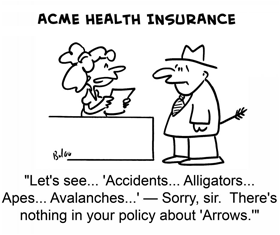Most Common Eligibility Exclusions
Eligibility exclusions occur when patients have coverage that does not include emergency visits or ambulance transports. For example, a commercial payer may provide dental, vision or prescription coverage only—not emergency services. Medicaid patients also have a common exclusion for family planning.
The bottom line? When running an eligibility transaction, yes isn’t always yes. Unexpected eligibility exclusions result in denied claims classified as “service rendered was not covered by the policy.”
How to Weed Out Exclusions
The goal in emergency medicine is to filter out eligibility exclusions before billing and claims submission. By incorporating exclusion notification within the billing workflow, emergency practices and ambulance companies save thousands of hours in staff time and operational expense. Here are three steps to take now:
- Determine which exclusions apply to your practice or business. Exclusions vary by patient population and regional payers. For example, Medicare coverage is often confirmed. But in many cases, it is for Part A only, not the Part B coverage required to reimburse for emergency visits or ambulance trips.
- With specific regional payers defined, ask your eligibility clearinghouse to filter out specialty-only benefits such as dental, vision, prescription or family planning before confirming coverage for encounters.
- Incorporate eligibility exclusions into your billing workflow on the front end. Determining coverage for ED or EMS services up front helps providers and ambulance companies save time and reduce denials.
When claims are denied because the emergency department or ambulance service isn’t covered, someone in billing must dig into the data and determine why. This is a lengthy process that takes significant time and money.
Quantifying the Problem
Even thirty minutes of time saved per encounter can drastically reduce operational costs. In our experience, emergency providers may have up to 35% of their encounters per week with no insurance on file. Of these accounts, AR Boost is able to locate insurance on roughly 25 percent. However, it is common to experience a 10 percent rate of exclusions.
For a group that is seeing or transporting 200,000 patients per year, this equates to about 100 cases per week requiring research to determine why services weren’t covered. At up to thirty minutes per record, one full-time billing position could be reallocated to a more profitable part of the billing process. Every hour saved is cost reduced.
Have you come across any cases of specialty exclusions? Share in the comments below!
Want to learn more about ways to tighten your eligibility verification process? Contact us or read more about how AR Boost’s technology and services support your efforts here.


 In these situations, it’s imperative that billing staff know the exact coverage and eligibility on the front end versus waiting until a claim is denied by the payer. This month’s blog explains how AR Boost (formerly Payor Logic) clients identify these types of eligibility exclusions early in the billing cycle, before hours of billing time, phone calls and mailings are wasted.
In these situations, it’s imperative that billing staff know the exact coverage and eligibility on the front end versus waiting until a claim is denied by the payer. This month’s blog explains how AR Boost (formerly Payor Logic) clients identify these types of eligibility exclusions early in the billing cycle, before hours of billing time, phone calls and mailings are wasted.